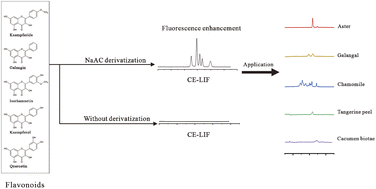Fluorescence enhancement of flavonoids and its application in ingredient determination for some traditional Chinese medicines by CE-LIF†
Abstract
Flavonoids are widely used in the treatment of various diseases due to their antioxidant, anti-inflammatory, anticancer and antiviral properties. Fluorescence detection is rarely applied for the determination of flavonoids because of their weak fluorescence. In this work, a method of fluorescence enhancement of flavonoids was firstly introduced by using sodium acetate for flavonoid derivatization. The study discovered that flavonoids, with a hydroxyl at the C3 position, had the ability to emit strong fluorescence after derivatization. Five flavonoids, kaempferide, galangin, isorhamnetin, kaempferol and quercetin, having a special structure, were selected, derivatized and analyzed by capillary electrophoresis with laser-induced fluorescence detection. Under the optimal conditions, the five flavonoids could be completely separated within 3 minutes. Good linear relationships were obtained for all analytes and the limits of detection for the five flavonoids were in the range of 1.18–4.67 × 10−7 mol L−1. Finally, the method was applied to the determination of flavonoids in five traditional Chinese medicines: aster, chamomile, galangal, tangerine peel and cacumen biotae. Flavonoids were successfully found in all these medicines by the developed method. The recoveries were in the range of 84.2–111%. The method developed in this study was fast, sensitive and reliable for the determination of flavonoids.



 Please wait while we load your content...
Please wait while we load your content...